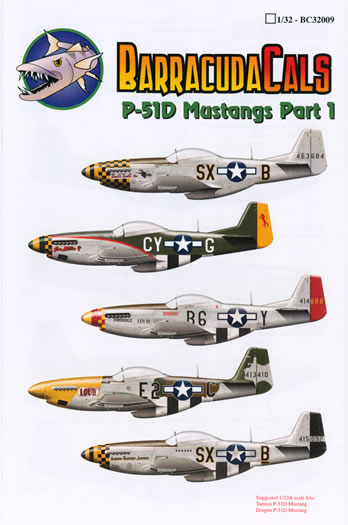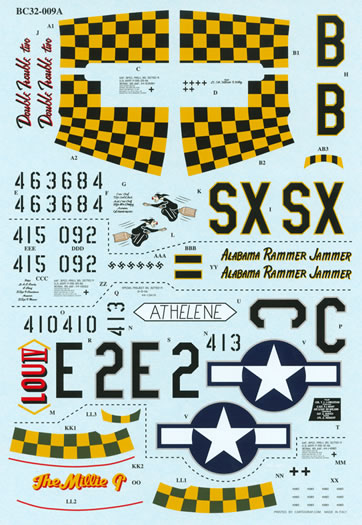P-51D Mustangs Part 1

BarracudaCals
1/72, 1/48 & 1/32 scales
S u m m a r y : |
Catalogue Number: |
BarracudaCals Item Nos. BC32009/BC48011/BC72009 - P-51D Mustangs Part 1 |
Scale: |
Available in 1/32, 1/48 and 1/72 scales |
Contents & Media: |
Decals for five subjects, colour-printed painting and markings guide, plus stencil placement guide. |
Price: |
Available on-line from BarracudaCals:
1/72 scale
USD$9.95
1/48 scale USD$11.95
1/32 scale USD$13.95
and Hannants from £6.25 |
Review Type: |
First Look |
Advantages: |
Excellent production quality and attractive subject choices. |
Disadvantages: |
Nothing of consequence. |
Conclusions: |
Excellent production quality, good instructions. |
Reviewed by Rodger Kelly

HyperScale is proudly supported by Squadron.com
BC32009/BC48011/BC72009 is BarracudaCals first sheet covering the North American P-51D Mustang. The sheet is available in 1/72, and 1/48 scale and I am sure that the 1/32 scale sheet will be popular with owners of the new 1/32 scale Tamiya Mustang kit.
Markings are provided for five European Theatre based machines of the 8th Air force, the details of each option are as follows:
- “Double Trouble Two” P-51D-20-NA serial number 44-63684, flown by Lieutenant Colonel “Wild” William Bailey of the 352nd Fighter Squadron, 353rd Fighter Group based at Raydon airfield in the UK between April 1944 and October 1945. The machine is in natural metal finish with an olive drab anti-glare panel and wears the 353rd fighter group identity markings of a yellow and black striped spinner and a black and yellow chequered nose.
- “The Millie G” of the 343rd Fighter Squadron, 55th Fighter Group flown by Major Edward Giller and based at Wormingford airfield in the UK between April 1944 and July 1945. The markings provided on the sheet allow you to model two different “Millie Gs”. The first one, serial number 44-14985 is a P-51D-15 which had red diagonal trim stripes, black and white D Day recognition markings on the underside of its fuselage, and a narrow red trim stripe to the nose checkers. The second “Millie G”, P-51D-15 serial number 44-15701 had yellow trim stripes and no D Day recognition markings. Both machines had RAF dark Green (or possibly olive drab) painted rear fuselages and empennages. Their spinners were green with a yellow band whilst their noses wore a thin band of yellow and green checkers as well as white bands around the horizontal stabilisers and black ones around the wings (these were theatre recognition markings). There are other detail differences between the two machines and the notes on the placement guide/information sheet point them out. Note that the name “Millie G” on the large decal sheet is yellow with a red surround whilst the smaller sheet has it as red with a green surround. The red and green one is the correct one to use.
- “Amorous Len III” P -51D-15-NA serial number 44-14888 of the 363rd Fighter Squadron 357th Fighter Group based at Leiston airfield in the UK between January 1944 and July 1945. The machine is overall natural metal finish with silver painted wings and an olive drab anti-glare panel. It wears the Group’s markings comprising a red and yellow spinner and red and yellow nose checkers. It also wears black and white D Day recognition markings on the underside of its fuselage as well as black Theatre recognition bands around the horizontal stabilisers and wings. The placement guide/information sheet advises that this is a fictional aircraft flown by a Captain “Reager” and that it can be easily adapted represent another well known aircraft. Indeed it can as the “missing” ingredients are supplied on the decal sheet as separate decals.
- “Lou IV”, P-51D-5-NA serial number 44-13410 of the 375th Fighter Squadron 361st Fighter Group. The machine was flown by the Group’s Commanding Officer Lieutenant Colonel. Thomas J. J. Christian from Bottisham airfield in the UK during the summer of 1944. If ever there was a P-51 that was argued over then this is it. The machine’s upper surfaces camouflage scheme has been reported as being painted in blue, ranging from a bright blue to a deep royal blue or either US olive drab or even RAF dark green. Either way, the machine started out in natural metal finish with an olive drab anti-glare panel before the debated top camouflage was applied. It wears the standard Group markings of a yellow spinner and nose as well as black and white D Day recognition markings on the underside of its fuselage and its wings.
- “Alabama Rammer Jammer” P-51D-15-NA serial number 44-51092 flown by Lieutenant Arthur Cundy a member of the 352nd Fighter Squadron 353rd Fighter Group based at Raydon airfield in the UK during the spring of 1945. The machine was in natural metal finish with silver painted wings and an olive drab anti-glare panel. Black theatre band recognition markings are worn on its wings and horizontal stabilisers as well as black and white D Day recognition markings on the underside of its fuselage. The spinner and nose checks are in yellow and black. This option can be built in two ways, as shown on the sheet with the three rows of nose checks, or later in its life when the checkers were extended as seen on the “Double Trouble Two” option.
The decals themselves have been printed by Cartograf.

They are quite comprehensive and include Group checkerboard markings as well as a comprehensive set of stencil data including individual data blocks for each option. A single set of national insignia is also supplied with the “Lou IV” option getting an extra pair with silver outlines to replicate the gap left between the silver of the fuselage and the marking when the fuselage was painted blue, or was it olive drab, or even RAF dark green?? The decals in the 1/32 scale pack are contained on three sheets (four if you count the smallest one that contains just one decal) whilst the 1/48 scale pack has two sheets and the 1/72 scale pack just one sheet. The decals are well printed indeed and there are no register issues on any of my sample sheets.
The placement guide/information guide comes in the form of two A-4 sized sheets that carry full colour left hand side profiles and upper surface plan views of each option as well as four-view line drawings to show stencil data placement. Comprehensive notes are provided for each option.
The suggested kits in 1/32 scale are the Tamiya and Dragon kits whilst the 1/48 scale one is the Tamiya and Hasegawa kits with the 1/72 scale ones being the Tamiya, Hasegawa and Revell ones.
The placement guide and decal sheets come packed in a clear plastic zip-loc bag.
Is this the tip of the iceberg from BarracudalCals when it comes to markings for the P-51? Let’s hope so as this sheet is well researched indeed and, when you combine it with good quality decals, the resulting models will look great.
Thanks to BarracudaCals for this sample.
Text and Images Copyright © 2011 by Rodger Kelly
This Page Created on 6 September, 2011
Last updated
7 September, 2011
Back to
HyperScale Main Page

|
